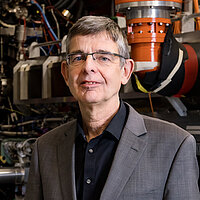Reactor types - The different paths to nuclear fusion
Why fusion has long been more than just a vision
07.07.2025
100 million degree plasma, lasers that ignite tiny hydrogen globules and reactors in the shape of a donut - the paths to controlled nuclear fusion could hardly be more different. Whether using strong magnetic fields in a tokamak or mini-explosions in inertial fusion, these technologies are competing for nothing less than the energy source of the future. But how far along are we really? And which approach has the greatest potential? Find out the answers in this interview with Prof. Dr. Hartmut Zohm, fusion researcher at the Max Planck Institute for Plasma Physics.

What reactor concepts are there in fusion research?
Prof. Dr. Zohm: In the last episode, we talked about the fact that you have to heat a hydrogen gas very strongly, up to 100 million degrees, then it becomes a so-called plasma. You have to contain this plasma. Ultimately, the concepts differ fundamentally in the idea of how it is enclosed. On the one hand, strong magnetic fields can be used to confine plasmas, i.e. gases made up of charged particles. This is because charged particles react to a magnetic field and travel along the magnetic field on their trajectories. This is known as magnetic confinement. A small bead of hydrogen can be heated very strongly with a fuel so that the outer layer evaporates, compressing the inner part of the bead and creating conditions similar to those in the sun. In the best case scenario, the bead burns up and generates more energy than was put into it to compress it. This is a miniaturized explosion and in this case the confinement only occurs within a few fractions of a second and only due to the inertia of the hydrogen or helium flying apart. This is why it is called inertial fusion.
There are two different types of magnetic fusion, the tokamak and the stellarator, what are the differences?
Prof. Dr. Zohm: The best configuration for confining a plasma is one in which the magnetic field has a so-called torus shape. The container in which it is confined looks like a donut or a bicycle inner tube, depending on the dimensions. This is done to avoid end losses. This is because particles travel along the magnetic field very quickly and always in a circle, never touching the wall. Tokamak and stellarator are such toridal magnetic confinement concepts. They differ in the way in which this magnetic field cage is used to confine the particles. With the stellarator, this is only done with external coils. In other words, all the electromagnets that generate the field are external and are built around the discharge vessel, so to speak. This is not the case with the tokamak. Here there are parts of the magnetic field that are generated externally with coils and other parts by a current that is allowed to flow in the plasma. Incidentally, this is very strong at one million amperes. This is the typical current strength in our experiments here in Garching at the Max Planck Institute for Plasma Physics. This allows the generator to run at a steady state without any further intervention. With the tokamak, you have to drive this current and ensure that the magnetic field cage remains in place.
Which of the two approaches would be better suited to industrial applications?
Prof. Dr. Zohm: In the long term, I think the stellarator is much more suitable, precisely because of this stationarity. You don't have to drive any currents from the inside and leave the plasma with no free energy, so to speak. However, the coil system of the stellarator is much more complex. This is why stellarators are one generation behind the tokamak in terms of technical evolution. For this reason, we are currently seeing many tokamaks, for example in the ITER experiment in southern France. This will probably be the first experiment to demonstrate this positive energy balance. But I believe that the stellarator will be ahead in the long term.
What exactly happens during inertial confinement fusion?
Prof. Dr. Zohm: You need a strong energy source that applies the energy to the sphere as spherically as possible, i.e. with spherical symmetry. Typically, a very strong laser is used for this. If the material is vaporized on the outside, it evaporates outwards and generates a recoil. This recoil compresses and heats the material so that the conditions inside are similar to those inside the sun. These cause the fuels of nuclear fusion to fuse together.
So the challenge on the way to the power plant is to create high pressure and high temperatures?
Prof. Dr. Zohm: You have to be a bit careful with the high pressure. This is true for inertial confinement fusion, where the pressure is really as high as in the interior of the sun because the matter is highly compressed. In magnetic confinement fusion, which is stationary, the density, i.e. the number of particles in the volume, is a million times lower than in our ambient air. This means that the pressure is something in the order of a few bars, i.e. a perfectly manageable number because it is confined in the magnetic field. The other approach is more like an explosion. In this case, the reaction is rather uncontrolled and releases the energy.

"We expect ITER to demonstrate for the first time in the 2030s that fusion reactions release more heat than is needed to heat and maintain the plasma temperature."
Prof. Dr. Hartmut Zohm
Scientific Member, Max Planck Institute for Plasma Physics and Honorary Professor, LMU Munich
What is behind the ITER project?
Prof. Dr. Zohm: ITER is a large project that is being set up by seven international partners in Cadarache in the south of France. It is a tokamak. So it is based on magnetic confinement because it is more advanced on the way to controlled nuclear fusion as an energy source. In the coming 2030s, we expect ITER to demonstrate for the first time that more heat can be released by fusion reactions than needs to be deposited in the plasma to heat it up. This is a so-called burning plasma, where the energy balance in the plasma is positive and essentially self-heated. A Q value of around ten must be achieved for this. That is the declared goal of ITER.
What does the European roadmap to such a functioning fusion power plant look like?
Prof. Dr. Zohm: ITER is the central element of this roadmap for magnetic fusion. ITER will provide scientific proof of an ignited, self-sustaining plasma state. There are many technological issues that need to be clarified in parallel. A demonstration power plant needs to be built to connect all these circuits and generate enough energy to ultimately feed into the grid, for example. It should be said that this roadmap initially had the plan to carry out ITER and the demonstration power plant sequentially. So ITER was supposed to show the scientific part and then we would build the technology experiment demo afterwards. In the meantime, we want to parallelize this as much as possible in order to make faster progress, because we have already learned a lot about the technology from ITER. It is currently being assembled, which means that most of the parts have been manufactured. So we now know how to build such large magnets and how to build the technology in a nuclear environment so that everything works. And we can already build on that.
What is happening with the other technologies and approaches, for example with the stellarator?
Prof. Dr. Zohm: Well, the stellarator is being very strongly pursued as an alternative, especially in Germany. We have the world's largest stellarator experiment, "Wendelstein 7-X" in Greifswald. This is operated by the Max Planck Institute for Plasma Physics. The stellarator will continue to be operated in parallel. However, there are plans and research to build new experiments, so that once the feasibility has been proven, a switch could be made. I think the stellarator is the better long-term concept. In order to make this switch without any problems during the transition, we need to start researching it now.
Has inertial fusion reached a similar point to the tokamak and stellarator, or where do we stand here?
Prof. Dr. Zohm: Inertial fusion has achieved great success in recent years. A bead like this has already been transferred to the field of burning. However, there is the problem that over the last few decades, research into inertial fusion has essentially been focused on military aspects. That's why all these technology components, which are incredibly important and which we have already developed in magnetic fusion, are nowhere near the level of maturity that exists in magnetic fusion. And in this respect, I think inertial fusion is where we were ten to 20 years ago with magnetic fusion. We still have to catch up. I think it will be possible in the future, but there is still a lot of technology to be investigated.
With magnetic fusion, it is assumed that a functioning power plant will be ready by 2050. Do you think this is realistic?
Prof. Dr. Zohm: That is very ambitious. In my opinion, it is possible if we continue and expand our research. We have had a research program up to now and we now need to embark on an industrial program in parallel, in which we build up an ecosystem of supplier industries that can manufacture the individual parts and then probably build the fusion power plant under the management of a large energy supplier. I'm always a bit cautious with timescales, we originally estimated 20 years for German fusion research. But that's 20 years from the day we get serious and put the necessary money on the table to create this ecosystem. Just because it is announced that it will take another 20 years does not mean that it will be ready in 20 years.
If you could christen the finished reactor, what name would you give it?
Prof. Dr. Zohm: I have to be honest and say that I hope it has a very unprosaic name, for example XYZ1B or something like that. That would then be the transition from what researchers do, which is to cultivate a bit of a name and personality cult, to what industrial products in large-scale production and series maturity mean. In this respect, I wouldn't choose a name that is particularly imaginative.
Discover also part 1 and part 3 of our interview with Prof. Dr. Hartmut Zohm, scientific member of the Max Planck Institute for Plasma Physics and honorary professor at the Ludwig-Maximilians-Universität Munich. The interview was conducted by Christoph Raithel, Management Consultant, Bayern Innovativ GmbH, Nuremberg.
On the way to the power plant: Tokamak, Stellarator & Co? (28.05.2025)
What types of reactor are there? What does the path to the first fusion power plant look like? Prof. Dr. Hartmut Zohm, Scientific Member of the Max Planck Institute for Plasma Physics and Honorary Professor at the Ludwig Maximilian University of Munich, reveals the answers.
Your contact





